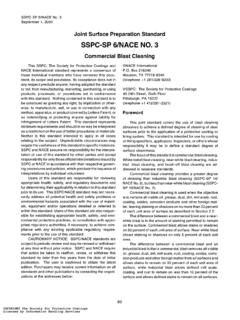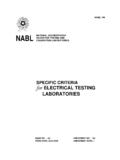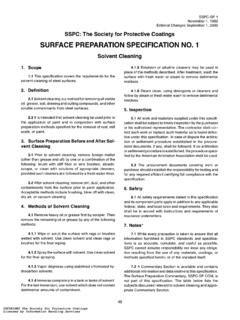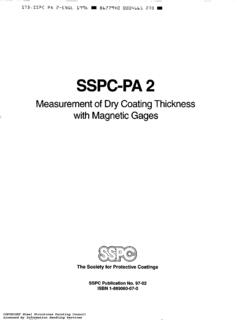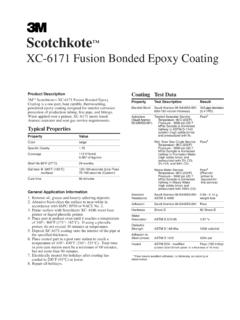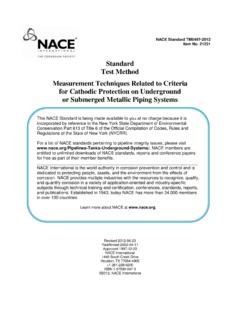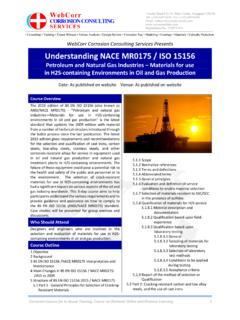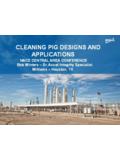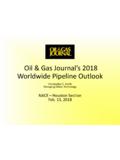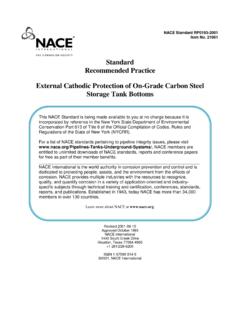Transcription of STD- RP027q-ENGL BNLICE NACE - Reli Sleeve
1 STD- NACE BNLICE " RP027q-ENGL NACE Standard RP0274-98 Item No. 21010 THE CORROSION SOCIETY Standard Recommended Practice High-Voltage Electrical Inspection of Pipeline Coatings This NACE International standard represents a consensus of those individual members who have reviewed this document, its scope, and provisions. Its acceptance does not in any respect preclude anyone, whether he has adopted the standard or not, from manufacturing, marketing, purchasing, or using products, processes, or procedures not in conformance with this standard. Nothing contained in this NACE International standard is to be construed as granting any right, by implication or otherwise, to manufacture, sell, or use in connection with any method, apparatus, or product covered by Letters Patent, or as indemnifying or protecting anyone against liability for infringement of Letters Patent.
2 This standard represents minimum requirements and should in no way be interpreted as a restriction on the use of better procedures or materials. Neither is this standard intended to apply in all cases relating to the subject. Unpredictable circumstances may negate the usefulness of this standard in specific instances. NACE International assumes no responsibility for the interpretation or use of this standard by other parties and accepts responsibility for only those official NACE International interpretations issued by NACE International in accordance with its governing procedures and policies which preclude the issuance of interpretations by individual volunteers. Users of this NACE International standard are responsible for reviewing appropriate health, safety, environmental, and regulatory documents and for determining their applicability in relation to this standard prior to its use.
3 This NACE International standard may not necessarily address all potential health and safety problems or environmental hazards associated with the use of materials, equipment, and/or operations detailed or referred to within this standard. Users of this NACE International standard are also responsible for establishing appropriate health, safety, and environmental protection practices, in consultation with appropriate regulatory authorities if necessary, to achieve compliance with any existing applicable regulatory requirements prior to the use of this standard. CAUTIONARY NOTICE: NACE International standards are subject to periodic review, and may be revised or withdrawn at any time without prior notice. NACE International requires that action be taken to reaffirm, revise, or withdraw this standard no later than five years from the date of initial publication.
4 The user is cautioned to obtain the latest edition. Purchasers of NACE International standards may receive current information on all standards and other NACE International publications by contacting the NACE International Membership Services Department, Box 218340, Houston, Texas 77218-8340 (telephone +I [281]228-6200). Reaffirmed 1993, 1998-25-03 Approved 1974-08 NACE International Box 21 8340 Houston, Texas 77218-8340 +I (281) 228-6200 ISBN 1-57590-064-5 O1 998, NACE International COPYRIGHT 2003; NACE International Document provided by IHS Licensee=Fluor Corporation/2110503105, User=, 01/16/2003 17:53:42 MST Questions or comments about this message: please callthe Document Policy Management Group at || | || | | ||| || | | ||||| | ||| | | | | || ---RP0274-98 Foreword Detection and correction of defects in protective coatings are important factors in an effective corrosion-control program.
5 High-voltage electrical inspection of pipeline coatings is one commonly used method of detecting such defects. Before the first issuance of this standard recommended practice, there had not been a national standard for electrical inspection of pipeline coatings other than AWWA(') Standard C 203-66,n Section , which is applicable to coal-tar coatings only. Several specifications have been written by operating companies for high-voltage electrical inspection of protective coatings, but these apply only to specific coatings. Adherence to the principles of this standard shall improve holiday detection of pipeline coatings. This standard is intended to be used by personnel in pipeline operating companies, pipeline contractors, pipeline inspection services, and pipeline coating mills.
6 This standard was originally prepared in 1974 by NACE International Task Group T-lOD-9 on Coating Inspection and Work Group T-lOD-9a on Electrical Inspection, components of Unit Committee T-1OD on Protective Coating Systems. It was reaffirmed with editorial revisions in 1993 and 1998. This standard was developed through the joint efforts of representatives of coating manufacturers, coating applicators, holiday detector manufacturers, corrosion specialists, and other personnel concerned with the construction of underground pipeline facilities. This standard is issued by NACE International under the auspices of Group Committee T-10 on Underground Corrosion Control. In NACE standards, the terms shall, must, should, and may are used in accordance with the definitions of these terms in the NACE Publications Style Manual, 3rd ed.
7 , Paragraph Shall and must are used to state mandatory requirements. Should is used to state that which is considered good and is recommended but is not absolutely mandatory. May is used to state that which is considered optional. (11 '*'AWWA C 203-66 (latest revision), "Coal-Tar Protective Coatings and Linings for Steel Water Pipelines - Enamel and Tape - Hot Applied (Denver, CO: AWWA). American Water Works Association (AWWA), 6666 W. Quincy Avenue, Denver, CO 80235. NACE International i COPYRIGHT 2003; NACE International Document provided by IHS Licensee=Fluor Corporation/2110503105, User=, 01/16/2003 17:53:42 MST Questions or comments about this message: please callthe Document Policy Management Group at || | || | | ||| || | | ||||| | ||| | | | | || ---STDeNACE RPD27LI-ENGL L778 b452981 0503955 bT5 m RP0274-98 NACE International Standard Recommended Practice High-Voltage Electrical Inspection of Pipeline Coatings Contents 1.)
8 General .. 1 2. Definitions .. 1 3. Testing Voltages .. 1 4. Grounding .. 2 5. Electrode .. 2 6. Electrode Travel Speed .. 2 7. Voltage Measurements .. 3 8. Condition of Coating Surface .. 3 9. Care of Equipment .. 3 ii NACE International COPYRIGHT 2003; NACE International Document provided by IHS Licensee=Fluor Corporation/2110503105, User=, 01/16/2003 17:53:42 MST Questions or comments about this message: please callthe Document Policy Management Group at || | || | | ||| || | | ||||| | ||| | | | | || ---STDmNACE RP0274-ENGL L778 b45298L 050L7Sh 531 W RP0274-98 Section 1: General Electrical inspection (holiday detection) is a test of the continuity of a protective coating.
9 This type of inspection does not provide information concerning coating resistance, bond, physical characteristics, or the overall quality of the coating, nor is it intended to do so. It detects bubble or blister-type voids, cracks, thin spots, and foreign inclusions or contaminants in the coating that are of such size, number, or conductivity as to lower the electrical resistance or dielectric strength of the coating significantly. Use of a holiday detector should be at the discretion of the coating inspector. An initial holiday inspection, performed as soon after the application of the coating as practicable, serves to check the materials and the application procedures. A final coating inspection, performed before lowering-in operations, will disclose any defect or damage (except disbonding) that has occurred during the construction period.
10 This standard presents acknowledged techniques for the use of holiday detectors currently used on pipeline coatings and presents a table of recommended voltages for various coating thicknesses. The recommendations contained herein do not apply to thin-film coatings ( .e., coating materials usually applied by a fusion-bonding process). Thin-film pipeline coatings are generally applied to a dry-film thickness less than mm (20 mils). Section 2: Definitions Holiday: A discontinuity in a protective coating that Pulse-type detector: A type of holiday detector which exposes unprotected surface to the environment. supplies a high-voltage pulse of very short duration ( , a pulse duration of seconds at a rate of 30 pulses Holiday detector: A device for locating discontinuities in per second).
